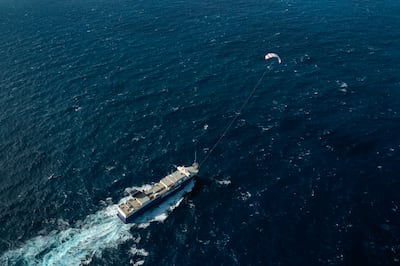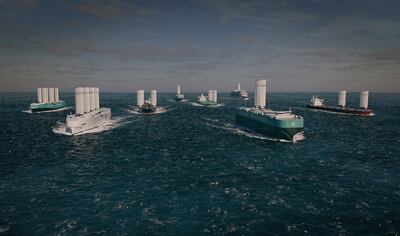When the Pamir sank with the loss of all but six of its crew, the tragedy appeared to draw a curtain on the sailing ships that had connected the globe through trade for thousands of years.
The vessel was considered to be the last ocean-going cargo sailing ship, but 66 years after she went down off the Azores, wind power is making a comeback as the world confronts the environmental effects of shipping.
After a week of wrangling, the International Maritime Organisation recently finally agreed a net-zero commitment for the reduction of greenhouse gases from the world’s cargo shipping, currently equivalent to the entire carbon output of Germany.
The UN body's work normally goes under the radar but this time London’s eco-protesters were out in force, with delegates treated to the sight of a woman in a mermaid outfit lying on the pavement to make the point about the environmental impact of the world’s shipping.
Currently the vast majority of the world's 100,000 cargo ships, which carry 90 per cent of the world's goods, are powered by engines that are often the size of four-storey houses and are fuelled by polluting heavy oil.
But from kites pulling ships to vessels almost entirely propelled by wind, technology exists or is in the pipeline that could change the way ships are powered and send the industry to a greener future, along the same trajectory as battery powered cars.
While it goes without saying that wind power isn't new, much of the technology being used to harness it is cutting edge.
“Wind is nice – it’s free of charge and who doesn’t love free energy? We’re not stealing wind from windmills,” Niclas Dahl, the managing director of the Oceanbird project, whose technology will drive a huge wind-powered cargo ship, told The National.

Alison Shaw, a research fellow at University College London’s Energy Institute, has been observing the IMO’s proceedings and believes the body has set the ball rolling on the adoption of new technology.
“What we’ve heard for a long time is that there’s a willingness from the shipping industry to move forward on zero-emission fuels and technology,” Dr Shaw said.
“But nothing has been particularly risk free, bankable or investable, so what was needed was a policy signal to set the pathway for the transition.”
Oceanbird promises a modern take on the sailing ships of 19th century and is perhaps the most eye-catching and ambitious shipping wind power project.
Giant wingsails attached to the ship have more in common with aircraft wings than sails. They capture the same aerodynamic forces that keep planes in the air, to power a ship along.
“It looks very much like an aeroplane wing and it is more or less like an aeroplane wing. When you put it on a ship vertically it creates a suction force taking it forward,” Mr Dahl said.
The ship still has an engine but Oceanbird says that 90 per cent of the time it will be powered by wind, even in the most challenging conditions. When the wind becomes too strong the wings can be lowered on to the deck, as they can to sail under bridges.

A key part of the technology is to allow a ship to sail almost directly into the wind, at an angle of as low as five degrees.
The first new vessel using its technology will be a car transporter, also able to carry cargo, built by one of Oceanbird’s two parent companies, shipbuilder Wallenius Wilhelmsen.
The 220m vessel will come equipped with six wing sails and will be able to carry 7,000 cars, anywhere in the world.
“What we do is sit down with potential customers and ask them to give us their route. We have all the wind data for the past 10 years so you can simulate the patterns. We then sail the route on a computer.”
In the meantime, Oceanbird has been building prototypes on land and will soon fit one of the wingsails to an existing ship for more testing.
Mr Dahl says the uncertainty of future supply for new fuels and the need for more vessels if speeds are reduced helps make the case for wind power.
He says wind-powered ships are on the same path as electric cars, with wind augmenting fuel-powered ships before fully taking over.
“Two or three years ago, more or less every electric car was a hybrid car and now it’s starting to go over to fully electric cars and I think you will see similar in this industry.
“We have a vision that we’re providing wings for a shipping revolution. Nowadays nobody thinks we're totally crazy.”
He says while there are regulatory issues to overcome, those in the industry are open to new ideas.
“When you talk to ship owners, they very often have their own sailing boats so they understand sailing and therefore think this is something that’s supercool and very exciting.”
Shipping revolution
While Oceanbird has a back-to-the-future glimmer, the Seawing giant kite is providing a solution a child would understand.
The kite is being developed by French company Airseas and will ultimately use a 1,000-square-metre surface kite to harness powerful winds, as it flies 300m above the ship.
It’s automatically launched from a platform and flies in a figure of eight using digital controls, to generate 36 times more pulling power than it would fixed in one position.
The idea is not to replace the ships' engines but allow them to substantially cut the amount of fuel used, be it the oil used now or ammonia or hydrogen in the future.
Chief executive Vincent Bernatets said the Seawing was born of his experience as a former Airbus aircraft engineer, wedded to his passion for the sea.
“I could see the impact of shipping on the oceans, so the idea came to use one to help the other,” he told The National.
Airseas is putting its design through sea trials in the Atlantic using the Ville De Bordeaux, a ship used to transport aircraft parts between Europe and the United States, as it fine tunes the kite’s automatic controls with the aim of getting the kites into production in 2026.
Already the company has signed a 20-year deal with Japanese shipping company K Line to retrofit 51 of its ships with the Seawings.
“Wind offers shipping companies the opportunity to be competitive ahead of the crowd,” Mr Bernatets said.

“What makes Seawing better? What we believe is it’s super simple but very powerful. You can retrofit it in less than a day. Simplicity and practicality are a very big focus for us.”
But he skirts around the obvious question about how the kite would work when the wind is blowing against the ship.
“There will be times when you don’t use the kite. On a transatlantic voyage we use it more than 50 per cent of the time. And the savings are 20 per cent.”
While Oceanbird and Seawing are at the cutting of edge of what’s possible with wind-powered ships, a tried-and-tested wind-power technology is already on ships.
Rotor sails, also known as Flettner rotors after their German inventor, are large spinning tubes that rely on what’s called the Magnus effect.
When wind passes a spinning rotor sail, the air flow accelerates on one side and decelerates on the opposite side, creating a thrust to power the ship forward perpendicular to the wind flow direction.
Giant leaps
The rotors have become an increasingly common sight on ships – they can also be folded on to the deck – over the past decade or so, thanks to companies such as Finland’s Norsepower.
Chief executive Tuomas Riski told The National the move towards carbon neutral fuels, such as ammonia or hydrogen, was actually an opportunity for his company in a market he estimates is worth about £50 billion ($65.5 billion).
“That means the energy needed to power ships will be several times more expensive and that will create a great demand for any devices that minimise the need for fuel.
“When these IMO regulations become stricter, we see the market for our mechanical sails taking giant leaps.”
Investors too are also beginning to wake up to the potential profits that can be made from the burgeoning market and Mr Riski says Norsepower recently attracted £24 million worth of funding this year as the company’s order book began to swell.

He explained that initially it was mostly northern European shipping companies but now “we’re selling worldwide”, including new customers from China, Japan and elsewhere in Asia.
“We’re a global market leader and the market is accelerating fast. Our aim is that within five years there will be 200 ships each year fitted with our technology.”
Casting his expert eye over the practicalities of how wind power is progressing is Richard Pemberton, lecturer in mechanical and marine engineering design at the University of Plymouth.
He said the main hurdle is not the viability of technology but how the “pieces of the jigsaw” all fit together.
It remains to be seen, for example, if modern complex supply chains can cope with the potential unpredictability of winds.
“Do the weather systems link up with the route? So because more people become involved, it starts becoming a more complex problem. Do we need bigger warehouses on land, for instance.”

Dr Shaw said the IMO is prepared to leave it to the industry to find the best solution to achieving net zero and while wind has a role, it will work in tandem with zero-emission fuels.
“When it comes to any energy efficiency options or wind assist or propulsion technology, the key thing is whether it’s right for a particular ship on a particular route,” she said.
“On some routes there’s reliable wind so for some ships it’s going to be a workable solution, but for others it’s going to be more about other types of energy efficiency and moving to zero-emission fuels.
“One thing that’s often missed is that it doesn’t have to be an either/or. Most likely we will see a future with energy efficient ships combining zero-emission fuels with wind assist or wind propulsion technologies on certain ship types and routes.”






